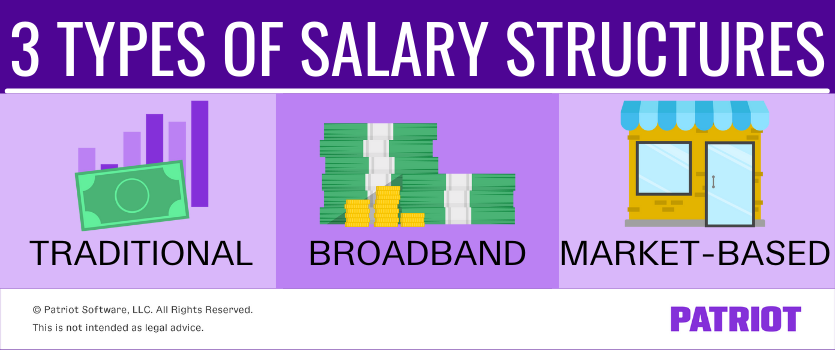If you’re a fan of organization, consider adding structure to how you determine salaries and raises. Learn about the different types of salary structure you can use in your small business.
What is a salary structure?
A salary structure, or pay scale, is a system that employers use to determine an employee’s compensation. A standard salary structure takes into account things like merit, length of employment, and pay compared to similar positions. Create a minimum and maximum salary within the structure.
You can create a salary structure to help when calculating a raise. To do so, break down each salary structure using pay grades.
Depending on your business, you may decide to use a combination of different types of salary structure.
Both you and your employees likely have expectations when it comes to compensation.
To get you and your employees on the same page, define your salary structure. That way, employees know their maximum earning potential.
Types of salary structure
There are three main types of salary structure businesses use:
- Traditional
- Broadband
- Market-based
According to one survey, the majority of businesses use market-based structures. And, the least common salary structure is broadband.
The type of structure you use may depend on your industry, business size, business location, and employee classification (i.e., exempt vs. nonexempt).
Keep in mind that you can change the salary structure you use. You don’t have to stick with the same type of structure, especially as your venture grows.
Understand the types of salary structure to choose the one that works best for your small business.

Traditional structure
Traditional salary structures are divided into numerous pay grades. Salary increases are relatively small jumps between pay grades. Employers can use traditional structures to prevent employees from capping out at the maximum salary too quickly.
Decide what an employee needs to do to move onto the next pay grade. You may use a variety of metrics to determine a pay raise, such as performance and length of employment.
Set the minimum and maximum salary range for each employee or employee group. Then, determine the number of pay grades within the structure.
Here’s an example traditional structure you can create for each department or group of employees:
| Pay Grade 1 | Pay Grade 2 | Pay Grade 3 | |
|---|---|---|---|
| Salary | $45k – $55k | $55k – $70k | $70k – $92k |
Broadband structure
Broadband structures are more flexible than traditional salary structures. These salary structures utilize fewer pay grades. And, each pay grade has a wider salary range than traditional structures.
If you use the broadband structure, you have more leeway when deciding an employee’s salary. You aren’t limited by a narrow salary range like a traditional structure.
However, using a broadband system can lead to greater pay inequalities between employees. Consider conducting a pay audit to identify pay disparities due to race, gender, disability, etc.
An employee may max out at the high end of their salary range if you implement a broadband salary structure. Although this might be great in the moment, the employee may start looking at other jobs when they no longer receive raises.
Here’s an example of a broadband salary structure:
| Pay Grade 1 | Pay Grade 2 | Pay Grade 3 | Pay Grade 4 | Pay Grade 5 | |
|---|---|---|---|---|---|
| Salary | $35k – $37k | $37k – $39k | $39k – $41k | $41k – $43k | $43k – $45k |
Market-based structure
Market-based structures are based on what other employers pay employees. Under a market-based salary structure, conduct an external pay audit to determine your salary ranges for each position.
To find out what workers are earning outside your business, do some research. Use resources like the U.S. Bureau of Labor Statistics or Glassdoor to see what employees in similar positions earn.
Put together a list of positions and their descriptions before collecting market data. That way, you can better compare positions.
In some ways, market-based structures are a combination of traditional and broadband salary structures. The salary ranges can be high like broadband structures, but the ranges are generally narrow and consistent.
Here’s an example market-based structure template:
| Pay Grade 1 | Pay Grade 2 | Pay Grade 3 | Pay Grade 4 | Pay Grade 5 | |
|---|---|---|---|---|---|
| Salary | $40k – $45k | $45k – $50k | $50k – $55k | $55k – $60k | $60k – $65k |
Don’t forget to update your payroll when you increase an employee’s salary. With Patriot’s online payroll software, entering an employee’s new hourly wage or salary is easy. And, we’ll calculate the employee’s new payroll tax liability. What are you waiting for? Get your free trial today!
This article has been updated from its original publication date of April 5, 2019.
This is not intended as legal advice; for more information, please click here.




